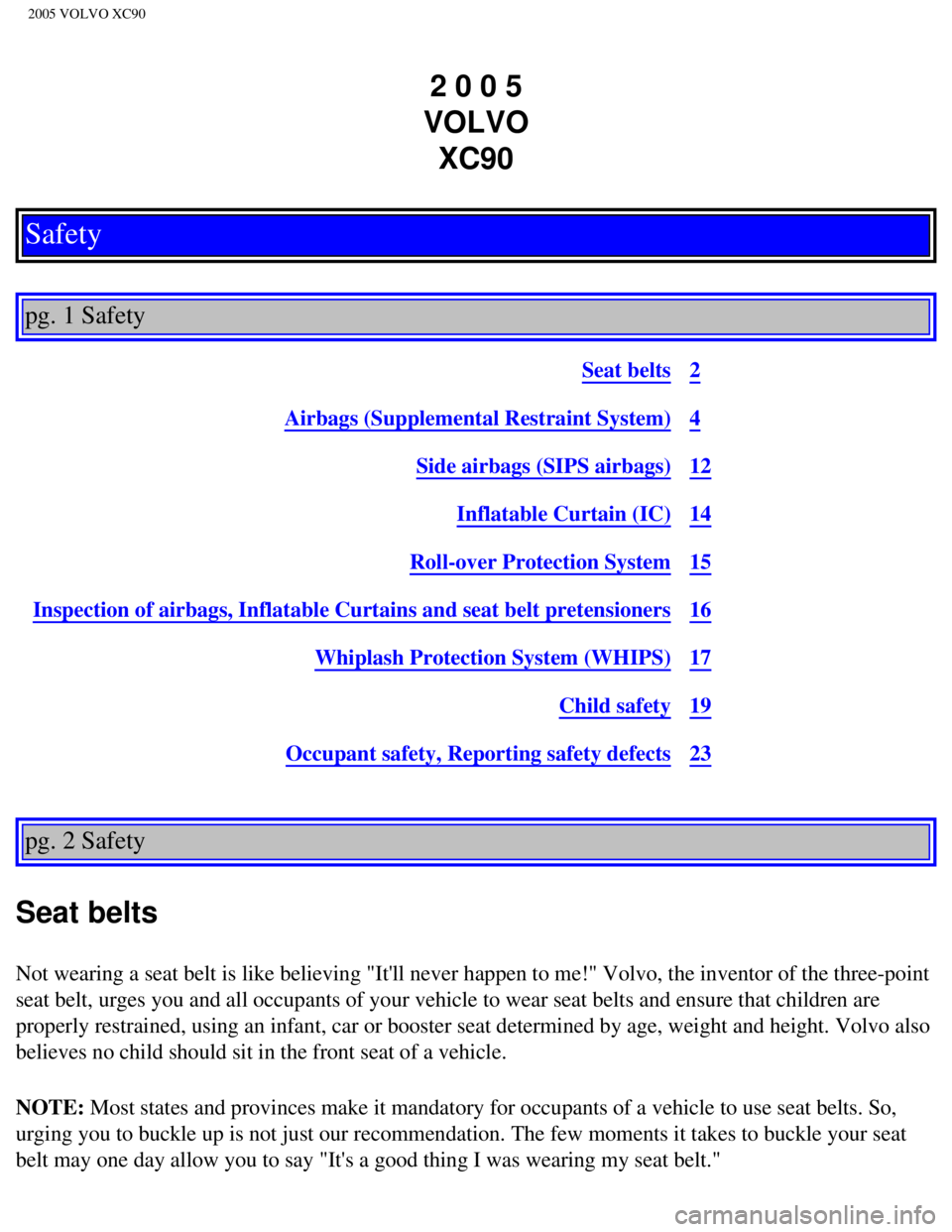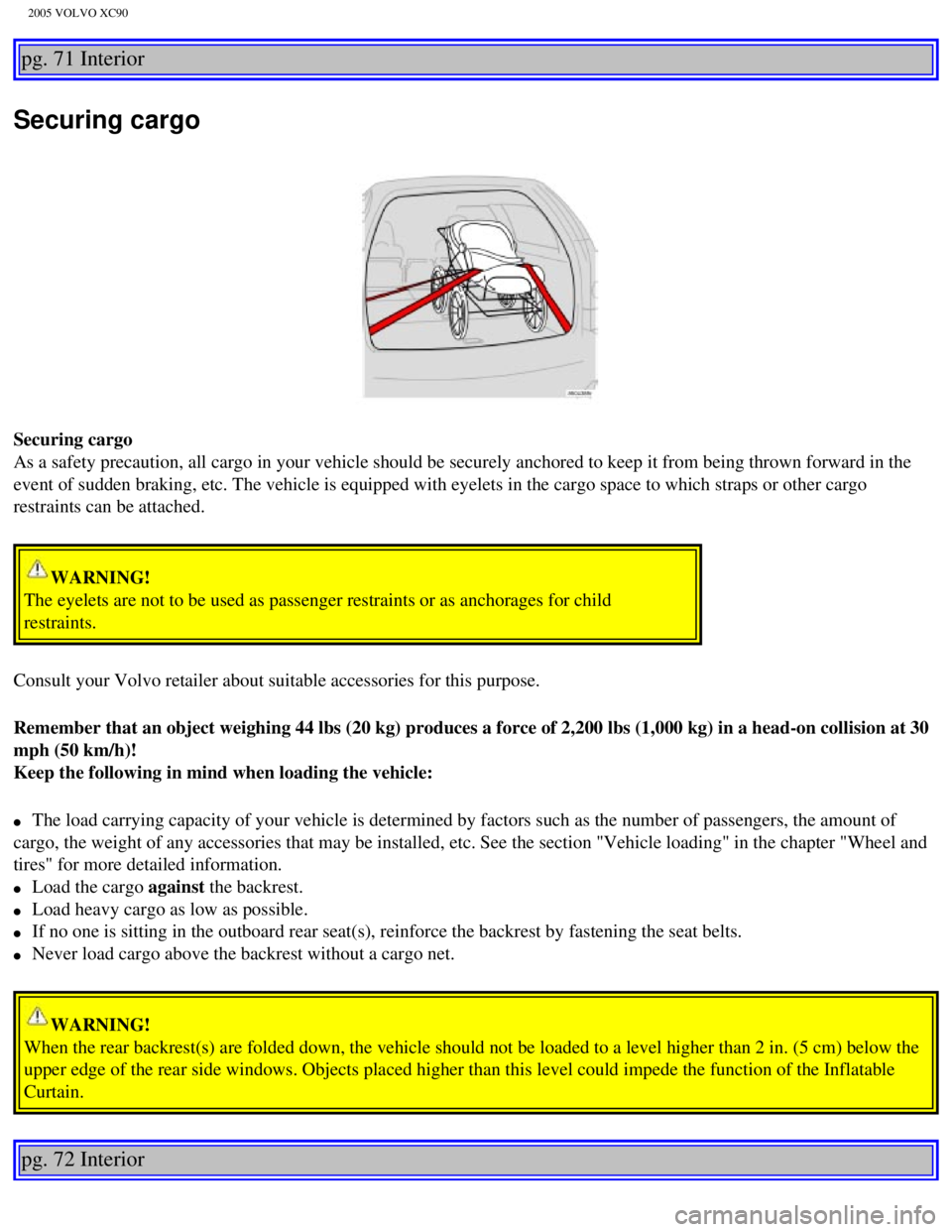2005 VOLVO XC90 weight
[x] Cancel search: weightPage 4 of 263

2005 VOLVO XC90
environmental impact of a product throughout its complete life cycle. In\
this context, design, production,
product use, and recycling are all important considerations.
In production, Volvo has partly or completely phased out several chemica\
ls including chlorofluorocarbons
(CFCs), lead chromates, naphtanates, asbestos, mercury and cadmium; an\
d reduced the amount of chemicals
used in our plants 50% since 1991.
Volvo was the first in the world to introduce into production a three-wa\
y catalytic converter with Lambda
Sond, now called oxygen sensor, in 1976. The current version of this hig\
hly efficient system reduces emissions
of harmful substances (CO, HC, NOx) from the exhaust pipe by approxima\
tely 95% and the search to eliminate
the remaining emissions continues. Volvo is the only automobile manufact\
urer to offer CFC-free retrofit kits
for the air conditioning system of all models as far back as the 1975 Vo\
lvo 240. Advanced electronic engine
controls, refined purification systems and cleaner fuels are bringing us\
closer to our goal.
After Volvo vehicles and parts have fulfilled their use, recycling is th\
e next critical step in completing the life
cycle. The metal content is about 75% of the total weight of a vehicle, \
which makes the vehicle among the most
recycled industrial products. In order to have efficient and well contro\
lled recycling, many Volvo variants have
printed dismantling manuals, indicating the weight and material of indiv\
idual components. For Volvo, all
homogeneous plastic parts weighing more than 1.7 oz. (50 grams) are ma\
rked with international symbols that
indicate how the component is to be sorted for recycling.
In addition to continuous environmental refinement of conventional gasol\
ine-powered internal combustion
engines, Volvo is actively looking at advanced technology alternative-fu\
el vehicles.
When you drive a Volvo, you become our partner in the work to lessen the\
vehicle's impact on the environment.
To reduce your vehicle's environmental impact, you can:
l Maintain proper air pressure in your tires. Tests have shown decreased f\
uel economy with improperly
inflated tires.
l Follow the recommended maintenance schedule in your Warranty and Service\
Records Information booklet.
l Drive at a constant speed.
l See an authorized Volvo retailer as soon as possible for inspection if t\
he check engine (malfunction
indicator) lamp illuminates, or stays on after the vehicle has started.\
l Properly dispose of any vehicle-related waste such as used motor oil, us\
ed batteries, brake pads, etc.
l When cleaning your vehicle, use Volvo's own vehicle care products, all o\
f which have systematically been
adapted to the environment.
For additional information regarding the environmental activities in whi\
ch Volvo Cars of North America, LLC
and Volvo Car Corporation are involved, visit our Internet home page at:\
http://www.volvocars.us
PremAir®
On the surface of the radiator in the engine compartment, there is a spe\
cial coating called PremAir®. PremAir®
file:///K|/ownersdocs/2005/2005_XC90/05xc90_00.htm (4 of 7)12/30/2006 \
4:42:22 PM
Page 8 of 263

2005 VOLVO XC90
2 0 0 5
VOLVO XC90
Safety
pg. 1 Safety
Seat belts2
Airbags (Supplemental Restraint System)4
Side airbags (SIPS airbags)12
Inflatable Curtain (IC)14
Roll-over Protection System15
Inspection of airbags, Inflatable Curtains and seat belt pretensioners16
Whiplash Protection System (WHIPS)17
Child safety19
Occupant safety, Reporting safety defects23
pg. 2 Safety
Seat belts
Not wearing a seat belt is like believing "It'll never happen to me!" Vo\
lvo, the inventor of the three-point
seat belt, urges you and all occupants of your vehicle to wear seat belt\
s and ensure that children are
properly restrained, using an infant, car or booster seat determined by \
age, weight and height. Volvo also
believes no child should sit in the front seat of a vehicle.
NOTE: Most states and provinces make it mandatory for occupants of a vehicle \
to use seat belts. So,
urging you to buckle up is not just our recommendation. The few moments \
it takes to buckle your seat
belt may one day allow you to say "It's a good thing I was wearing my se\
at belt."
file:///K|/ownersdocs/2005/2005_XC90/05xc90_01a.htm (1 of 15)12/30/200\
6 4:42:24 PM
Page 15 of 263

2005 VOLVO XC90
WARNING!
Children must never be allowed in the front passenger's seat. Volvo reco\
mmends that ALL occupants
(adults and children) shorter than 4 feet 7 inches (140 cm) be seate\
d in the back seat of any vehicle
with a front passenger-side airbag. See
page 22 for guidelines.
Occupants in the front passenger's seat must never sit on the edge of th\
e seat, sit leaning toward the
instrument panel or otherwise sit out of position. The occupant's back m\
ust be as upright as comfort
allows and be against the seat back with the seat belt properly fastened\
.
Feet must be on the floor, e.g. not on the dash, seat or out of the wind\
ow.
No objects or accessory equipment, e.g. dashboard covers, may be placed \
on, attached to, or installed
near the SRS hatch (the area above the glove compartment) or the area \
affected by airbag deployment
(see illustration on
page 4).
There should be no loose articles, e.g. coffee cups, on the floor, seat \
or dashboard area.
Never try to open the SRS cover on the steering wheel or the passenger s\
ide dash. This should only be
done by an authorized Volvo service technician.
Failure to follow these instructions can result in injury to the vehicle\
occupants.
Safety system warning light in the instrument panel
A self-diagnostic system incorporated in the sensor monitors certain saf\
ety system components. A check
is performed on components such as seat belt locks, SRS, Occupant Weight\
Sensor, SIPS, and/or the
VIC system. If a fault is detected, the warning light will illuminate. T\
he light is included in the warning/
indicator light cluster in the instrument panel. Normally, the safety sy\
stem warning lamp should light up
when the ignition key is turned to positions I, II or III and should go \
out after approximately 7 seconds
or when the engine is started. Check that this light is functioning prop\
erly every time the vehicle is
started.
WARNING!
If the SRS warning light stays on after the engine has started or if it \
comes on while you are driving,
drive the vehicle to the nearest authorized Volvo retailer for inspectio\
n as soon as possible.
file:///K|/ownersdocs/2005/2005_XC90/05xc90_01a.htm (8 of 15)12/30/200\
6 4:42:24 PM
Page 16 of 263

2005 VOLVO XC90
pg. 7 Safety
Disabling the passenger's side front airbag.
Volvo recommends that ALL occupants (adults and children) shorter than\
four feet seven inches (140
cm) be seated in the back seat of any vehicle with a front passenger si\
de airbag, and be properly
restrained for their size and weight. See also the child safety recommen\
dations on
page 22.
The passenger's side front airbag is automatically enabled/disabled by t\
he Occupant Weight Sensor
(OWS), a system that monitors the weight of the person or object in th\
e front passenger's seat. The
system consists of a silicon-filled bag located under the padding in the\
front passenger's seat cushion, a
control module located under this seat, and a seat belt tension sensor, \
located on the outboard side of the
seat.
file:///K|/ownersdocs/2005/2005_XC90/05xc90_01a.htm (9 of 15)12/30/200\
6 4:42:24 PM
Page 18 of 263

2005 VOLVO XC90
WARNING! If a fault in the system is detected and indicated as explained above, \
be aware that
the passenger's side front airbag will not deploy in the event of a coll\
ision. In this case, the safety
systems and Occupant Weight Sensor should be inspected by an authorized \
Volvo retailer as soon as
possible.
pg. 8 Safety
WARNING!
Never try to open, remove, or repair any components in the OWS system. T\
his could result in system
malfunction. Maintenance or repairs should only be carried out by an aut\
horized Volvo service
technician.
WARNING!
Keep the following points in mind with respect to the OWS system. Failur\
e to follow these
instructions could adversely affect the system's function and result in \
serious injury to the occupant of
the front passenger's seat:
The full weight of the front seat passenger should always be on the seat\
cushion. The passenger
should never lift him/herself off the seat cushion using the armrest in \
the door or the center console,
by pressing the feet on the floor, by sitting on the edge of the seat cu\
shion, or by pressing against the
backrest in a way that reduces pressure on the seat cushion. This could \
cause OWS to disable the
front, passenger's side airbag.
The front passenger's seat should not be modified in any way. This could\
reduce pressure on the seat
cushion, which might interfere with the OWS system's function.
Do not place any type of object on the front passenger's seat in such a \
way that jamming, pressing, or
squeezing occurs between the object and the front seat, other than as a \
direct result of the correct use
of the ALR/ELR seat belt (see
page 22).
No objects should be placed under the front passenger's seat. This could\
interfere with the OWS
system's function.
file:///K|/ownersdocs/2005/2005_XC90/05xc90_01a.htm (11 of 15)12/30/20\
06 4:42:24 PM
Page 19 of 263

2005 VOLVO XC90
WARNING!
No objects that add to the total weight on the seat should be placed on \
the front passenger's seat. If a
child is seated in the front passenger's seat with any additional weight\
, this extra weight could cause
the OWS system to enable the airbag, which might cause it to deploy in t\
he event of a collision,
thereby injuring the child. The seat belt should never be wrapped around\
an object on the front
passenger's seat. This could interfere with the OWS system's function.
The front passenger's seat belt should never be used in a way that exert\
s more pressure on the
passenger than normal. This could increase the pressure exerted on the w\
eight sensor by a child, and
could result in the airbag being enabled, which might cause it to deploy\
in the event of a collision,
thereby injuring the child.
pg. 9 Safety
When are the airbags deployed?
The information on this page pertains to SRS (front) airbags only. For\
information about Side Impact
Protection System (SIPS) airbags, please see
page 12. For Inflatable Curtain (IC) airbags, please see
page 14.
The SRS system is designed to deploy during certain frontal or front-ang\
ular collisions, impacts, or
decelerations, depending on the crash severity, angle, speed and object \
impacted. The SRS sensor is
designed to react to both the impact of the collision and the inertial f\
orces generated by it and to
determine if the intensity of the collision is sufficient for the seat b\
elt pretensioners or airbags to be
deployed.
If the airbags have been deployed, we recommend the following:
l Have the vehicle towed to an authorized Volvo retailer. Never drive with\
the airbags deployed.
l Have an authorized Volvo retailer replace the SRS system components.
l Use only new, Genuine Volvo Parts when replacing SRS components (airbag\
s, seat belts,
pretensioners, etc.).
When are the airbags NOT deployed?
Not all frontal collisions activate the SRS system. If the collision inv\
olves a nonrigid object (e.g., a snow
drift or bush), or a rigid, fixed object at a low speed, the SRS system\
will not necessarily deploy. Front
airbags do not normally deploy in a side impact collision, in a collisio\
n from the rear or in a rollover
situation. The amount of damage to the bodywork does not reliably indica\
te if the airbags should have
deployed or not.
Seat belts - the heart of the Volvo safety system
The heart of the Volvo safety system is the three-point seat belt (a Vo\
lvo invention)! In order for the
SRS system to provide the protection intended, seat belts must be worn a\
t all times by everyone in the
file:///K|/ownersdocs/2005/2005_XC90/05xc90_01a.htm (12 of 15)12/30/20\
06 4:42:24 PM
Page 31 of 263

2005 VOLVO XC90
Holding a child in your arms is NOT a suitable substitute for a child re\
straint system. In an accident, a
child held in a person's arms can be crushed between the vehicle's inter\
ior and an unrestrained person.
The child could also be injured by striking the interior, or by being ej\
ected from the vehicle during a
sudden maneuver or impact. The same can also happen if the infant or chi\
ld rides unrestrained on the
seat. Other occupants should also be properly restrained to help reduce \
the chance of injuring or
increasing the injury of a child.
All states and provinces have legislation governing how and where childr\
en should be carried in a
vehicle. Find out the regulations existing in your state or province. Re\
cent accident statistics have shown
that children are safer in rear seating positions than front seating pos\
itions when properly restrained. A
child restraint system can help protect a child in a vehicle. Here's wha\
t to look for when selecting a child
restraint system:
l It should have a label certifying that it meets applicable Federal Motor\
Vehicle Safety Standards
(FMVSS 213) - or in Canada, CMVSS 213.
l Make sure the child restraint system is approved for the child's height,\
weight and development - the
label required by the standard or regulation, or instructions for infant\
restraints, typically provide this
information.
l In using any child restraint system, we urge you to carefully look over \
the instructions that are
provided with the restraint. Be sure you understand them and can use the\
device properly and safely in
this vehicle. A misused child restraint system can result in increased i\
njuries for both the infant or child
and other occupants in the vehicle.
When a child has outgrown the child safety seat, you should use the rear\
seat with the standard seat belt
fastened. The best way to help protect the child here is to place the ch\
ild on a cushion so that the seat
belt is properly located on the hips (see
page 2). Legislation in your state or province may mandate the
use of a child seat or cushion in combination with the seat belt, depend\
ing on the child's age and/or size.
Please check local regulations.
A specially designed and tested booster cushion (not available in Canad\
a) can be obtained from your
Volvo retailer for children weighing 33-80 lbs (15-36 kg) and 38-54 in\
ches (97-137 cm) in height.
file:///K|/ownersdocs/2005/2005_XC90/05xc90_01b.htm (9 of 16)12/30/200\
6 4:42:25 PM
Page 97 of 263

2005 VOLVO XC90
pg. 71 Interior
Securing cargo
Securing cargo
As a safety precaution, all cargo in your vehicle should be securely anc\
hored to keep it from being thrown forward in the
event of sudden braking, etc. The vehicle is equipped with eyelets in th\
e cargo space to which straps or other cargo
restraints can be attached.
WARNING!
The eyelets are not to be used as passenger restraints or as anchorages \
for child
restraints.
Consult your Volvo retailer about suitable accessories for this purpose.\
Remember that an object weighing 44 lbs (20 kg) produces a force of 2,\
200 lbs (1,000 kg) in a head-on collision at 30
mph (50 km/h)!
Keep the following in mind when loading the vehicle:
l The load carrying capacity of your vehicle is determined by factors such\
as the number of passengers, the amount of
cargo, the weight of any accessories that may be installed, etc. See the\
section "Vehicle loading" in the chapter "Wheel and
tires" for more detailed information.
l Load the cargo against the backrest.
l Load heavy cargo as low as possible.
l If no one is sitting in the outboard rear seat(s), reinforce the backr\
est by fastening the seat belts.
l Never load cargo above the backrest without a cargo net.
WARNING!
When the rear backrest(s) are folded down, the vehicle should not be l\
oaded to a level higher than 2 in. (5 cm) below the
upper edge of the rear side windows. Objects placed higher than this lev\
el could impede the function of the Inflatable
Curtain.
pg. 72 Interior
file:///K|/ownersdocs/2005/2005_XC90/05xc90_04b.htm (5 of 9)12/30/2006\
4:42:31 PM